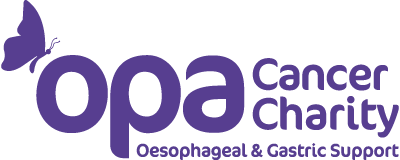Keeping it in the Family
In the first of two articles, David Eaves explains how the collection and study of data may lead to an improvement of outcomes for oesophageal patients. David represents the Oesophageal Patients Association on the National Oesophago-Gastric Cancer Audit and is a member of the Leeds Region.
Every visit to an NHS or NHS-funded service results in vast amounts of data that are collected and collated by NHS Digital[1], the part of the NHS where I now work. The data are used for many reports and statistics, never attempting or needing to know who any of the individuals are. But research organisations and charities and other organisations can apply to have data sent to them for specifically agreed purposes and under strict conditions, including length of time the data may be used and stored. Under certain restricted conditions, where individuals in studies have consented[2], data for these patients can be sent encoded in such a way to allow these organisations (and only those individual organisations for those specific purposes) to identify those patients (and only those patients). Hospital data, in-patient, out-patient, emergency care, maternity care, mental health data, prescribing data, births data, mortality data, a patient’s entire journey through the NHS, and only ever those who absolutely need to know, and are legally permitted, being able to determine who those people actually are. The possibilities are vast.
One important use of these data, and most relevant to us, is Clinical Audit. Every year CARMS, the Clinical Audit and Registries Management Service in NHS Digital, collects and collates data from many sources for audits for many different areas: the National Diabetes Audit, the National Bowel Cancer Audit, Pulmonary Hypertension, Out-of-Area mental health Placements, and of course the National Oesophago-gastric Cancers Audit (NOGCA). Because of the similarities of stomach cancer and oesophageal cancer and their treatment regimes, these two are studied together.
NOGCA collects data from all patients diagnosed with OG cancer and links it to other data, such as mortality and chemotherapy data. This rich data source is analysed and report published each year. The audit is able to identify: the outcomes of care; whether care meets national guidelines; and variations in practice, for example chemotherapy regimens.
By identifying variations, the audit prompts national clinical discussion and facilitates the sharing of best practice. The latest annual report was published recently and is available, along with previous reports and other resources, on the NOGCA website[3]. Some key findings in the latest audit include:
There is a need to investigate how to improve early diagnosis and investigate the reasons for high rates of diagnosis after emergency admission.
There is still a need to improve waiting times between referral and treatment In line with clinical recommendations, the use of CT scans for initial assessment has increased, as has the use of PET-CT scans for patients being considered for curative treatment, though with some regional variation
There are regional differences in the proportion of patients managed with curative intent and in the types of palliative treatment used
There is still a high standard of surgical care in England and Wales[4] with low mortality rates after curative surgery.
By examining previous reports and data it’s possible to see how the improvements in practice recommended by these audits are improving patient outcomes. These reports are, of course, generally aimed at the clinical community and for nearly everyone reading this (apologies for the sweeping assumptions) they will be difficult to understand. The charts are also unhelpful if you don’t understand the specific data behind it and what they mean, so please don’t start looking at them and start panicking.
A welcome innovation for the 2017 report was input from patients and a dedicated patient-focused supplement. This report is available on the NOGCA website.
The latest at the time of writing is still the 2017 one; the 2018 patient report is not yet complete but will be released in due course. The OPA are developing stronger links with the audit and hope to be able to influence additional areas to study through increased patient experience feedback. You can begin to take part now by discussing this in your regional meetings and emailing OPA.AuditFeedback@icloud.com. CARMS have indicated they’d be willing to talk to other regional meetings about the audit, and I would be happy to discuss how we as patients can help.
The photograph is of David with his father. His father died in August 2009 of oesophageal cancer. Three years later in 2012 David was diagnosed with oesophageal cancer and had an oesophagectomy. In the second article to be published in the newsletter in the Spring he will outline his experiences of oesophageal cancer and query whether hereditary factors may be of relevance.
Links:
NOGCA main website [https://www.nogca.org.uk/]
NOGCA 2018 Audit Report [https://www.nogca.org.uk/
NOGCA 2017 Audit Report [https://www.nogca.org.uk/
NOGCA 2017 Patient Report [https://www.nogca.org.uk/
(1) in full compliance with all laws and guidelines; primarily for
patient care but also for payments, costings and performance
(2) Patient Objections. For more information, please see http://
nhs.uk/your-nhs-data-matters
(3) Relevant weblinks are available on the OPA website.
(4) NOGCA 2018 p39, Key Finding 2 and recommendation




Comments are closed.